Sophia Learning
Sophia: Determining Denotation
This lesson explains how to determine the denotation of words; it defines denotation and offers a plan of action: look up the word in the dictionary, read all meanings paying attention to parts of speech, and compare each of these...
Savvas Learning
Pearson Education: The Longman Vocabulary Website: Using Context Clues
Discover how to use context clues to improve your reading skills. This resource features exercises for beginners, intermediate and advanced students. L.9-10.4a, L.8.2.B Context/Meaning
Texas Education Agency
Texas Gateway: Reference Materials Printed and Electronic
Learn how to use dictionaries, glossaries, and thesauri in order to determine meanings of words and phrases, including their denotations, connotations, and etymologies.
Texas Education Agency
Texas Gateway: Applying Word Study Strategies (English I Reading)
Apply previous lessons, (1) Linguistic Roots and Affixes, (2) Denotation and Connotation, (3) Origins and Meanings of Foreign Words, (4) Cognates, and (5) Reference Materials, to improve fluency and comprehension.
Texas Education Agency
Texas Gateway: Reference Materials: Printed and Electronic
You will learn how to use dictionaries, glossaries, and thesauri in order to determine meanings of words and phrases, including their denotations, connotations, and etymologies.
Lumen Learning
Lumen: Rhetorical Reading: Read Strategically: Diversify Your Vocabulary
This lesson focuses on strategies to diversify and retain new vocabularies such as reading a variety of types of writing and learning roots, suffixes, prefixes, and the etymology of words.
ClassFlow
Class Flow: Developing Vocabulary Context Clues
[Free Registration/Login Required] This interactive whiteboard lesson is designed to help students develop their vocabulary by recognizing and analyzing context clues with unfamiliar words.
Education.com
Education.com: L.3.4.a Worksheets: Sentence Level Context as a Clue to Meaning
[Free Registration/Login Required] A site with links to 30 worksheets that can be downloaded and printed for student use while building skills with standard L.3.4.A: Use sentence-level context as a clue to the meaning of a word or phrase.
Better Lesson
Better Lesson: L.3.4d: Use Glossaries or Dictionaries to Determine Meaning
Links to 2 lessons and activities that build student skills in standard L.3.4d: Use glossaries or beginning dictionaries, both print and digital, to determine or clarify the precise meaning of key words and phrases.
Better Lesson
Better Lesson: W.4.2d: Use Precise Language and Vocabulary
Links to 27 lessons and activities that build student skills in standard W.4.2d: Use precise language and domain specific vocabulary to inform about or explain the topic.
Learning Farm
Learning Farm: Common Core Standards: Dictionaries, Glossaries, Thesaurus
Learn about different reference materials such as dictionaries, glossaries, and thesauri to help you learn meanings of words, pronunciation, or parts of speech. View a short lesson then practice using Game Mode or Test Mode.
ICT Games
Ict Games: Pre Loaded Dictionary for Years 1 and 2
A resource that lists vocabulary words for guided writing.
Annenberg Foundation
Annenberg Learner: Journey North: Reading Strategies: Use Context Clues to Decipher Words
This reading resource discusses the strategy of using context clues to decipher new words. A list of guiding questions is provided to help students as they use context clues to understand new words.
Florida Center for Reading Research
Florida Center for Reading Research: Words in Context: If the Word Fits
A lesson plan in which learners work with a partner to choose the meaning of the underlined word in each sentence. Materials are included.
Florida Center for Reading Research
Florida Center for Reading Research: Word Knowledge: Homograph Hitch
A lesson plan in which students match two definitions to each homograph. Materials are included.
Florida Center for Reading Research
Florida Center for Reading Research: Vocabulary: Words in Context [Pdf]
A lesson plan in which students look for new vocabulary words and context clues to define them while reading an independent reading book. Materials are included.
Florida Center for Reading Research
Florida Center for Reading Research: Words in Context: Looking for Meaning [Pdf]
A lesson plan in which students look for the meanings of unknown words in a text. Materials are included.
Florida Center for Reading Research
Florida Center for Reading Research: Morpheme Structures: Word Way [Pdf]
A lesson plan in which students identify unknown words within a text, identify their parts and syllables, and work to determine the meaning of each word. Materials are included.
CPALMS
Cpalms: Building Meaning
In this tutorial, students will acquire tools from Handy Hal that will help them answer questions about unknown words in a text. Students will learn about word parts, picture clues, and context clues to help them with vocabulary...
PBS
Pbs Learning Media: How to Use Reference Materials
A dictionary is one of the most useful reference books anybody could ever use. Learn how to properly understand a dictionary's formatting and content! [0:46]
Folger Shakespeare Library
Folger Shakespeare Library: Close Reading Shakespeare's Sonnets
This lesson plan teaches students to consider diction, syntax, literary devices, and rhetorical strategies in doing a close reading of Shakespeare's sonnets.
Khan Academy
Khan Academy: Clarifying Meaning Quick Guide
In a given text, words and phrases do not appear in isolation but are embedded in the context of a narrative, an argument, an explanation, and so on. Accordingly, clarifying meaning questions test your ability to identify contextually...
Grammar Tips
Who, That, Which
Need a quick reference for when to use who, that or which? This article offers a concise explanation.
Primary Resources
Primary Resources: To Order Words According to Shades of Meaning [Pdf]
This PDF activity has students order lists of words with similar meanings from the weakest to the strongest in meaning, select words with strongest meaning to fill in the blanks, make a list of words that mean happy, and then use them to...


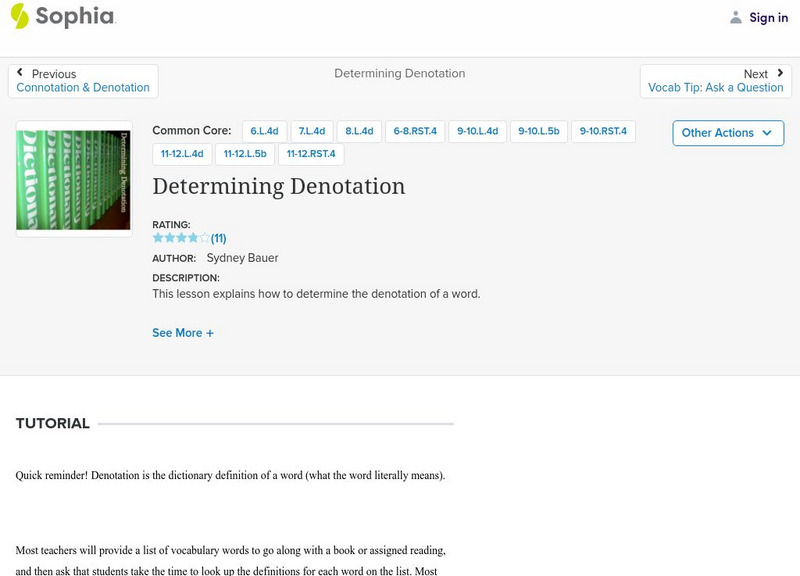
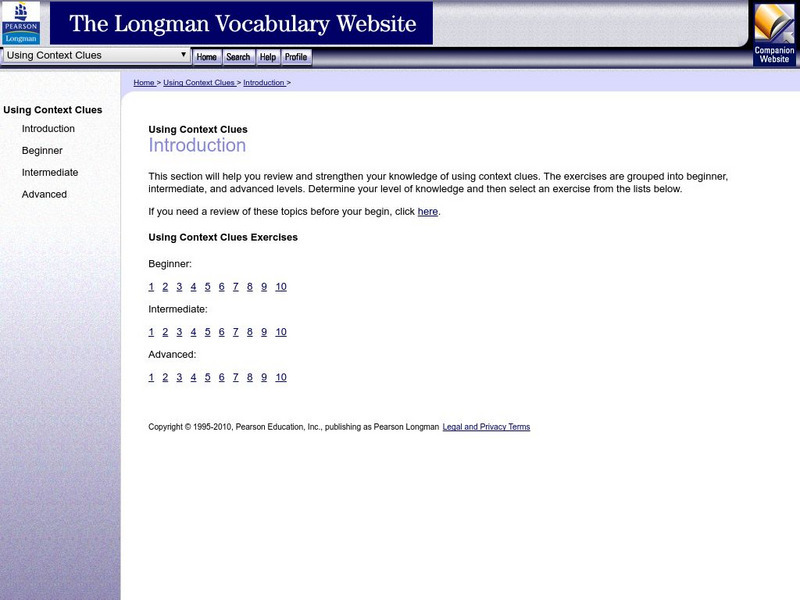






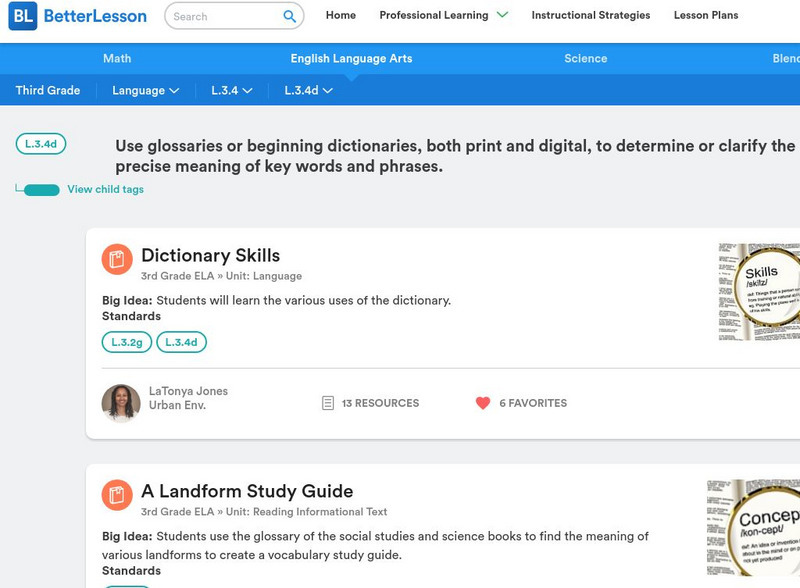

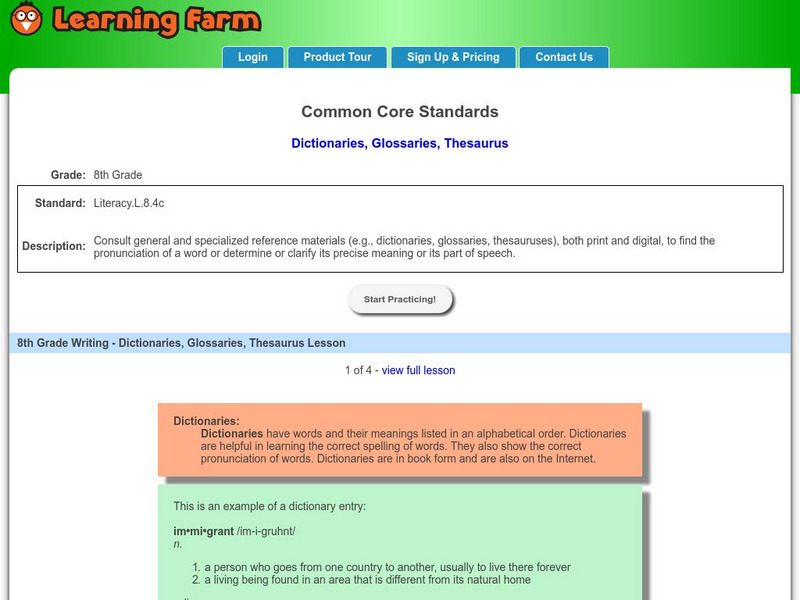

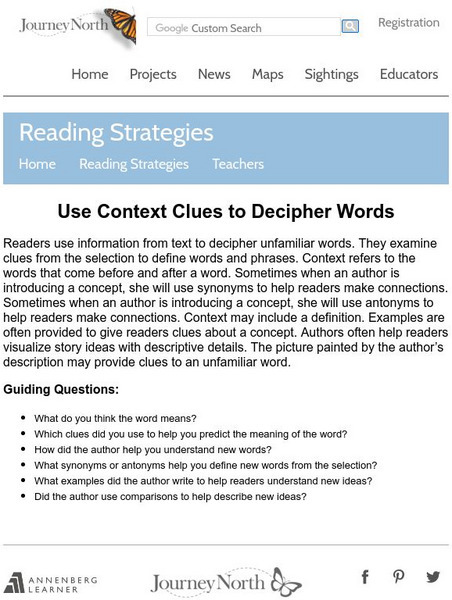
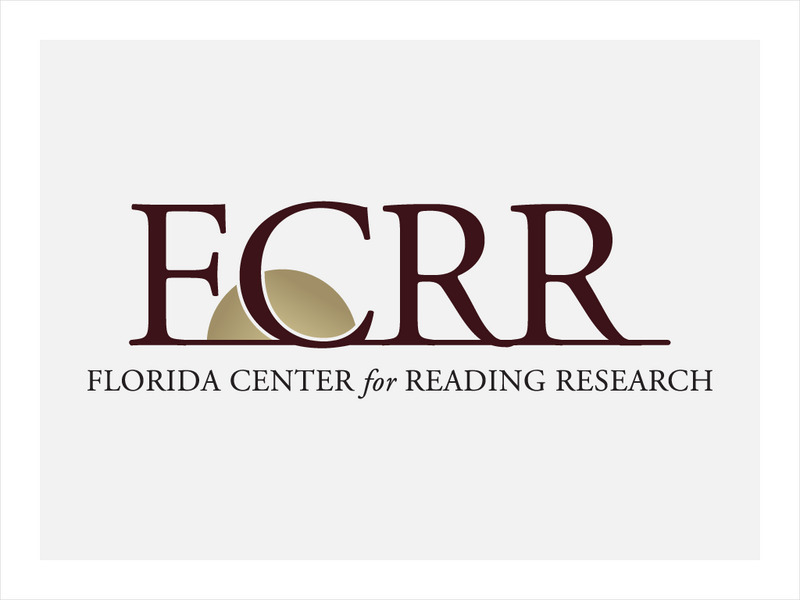

![Florida Center for Reading Research: Vocabulary: Words in Context [Pdf] Lesson Plan Florida Center for Reading Research: Vocabulary: Words in Context [Pdf] Lesson Plan](https://content.lessonplanet.com/knovation/original/509075-bf705fa52db363685aedc39f5902d6e3.jpg?1661787010)
![Florida Center for Reading Research: Words in Context: Looking for Meaning [Pdf] Lesson Plan Florida Center for Reading Research: Words in Context: Looking for Meaning [Pdf] Lesson Plan](https://content.lessonplanet.com/knovation/original/509076-6a14ed968316cda8b9a394daa7faca88.jpg?1661787008)
![Florida Center for Reading Research: Morpheme Structures: Word Way [Pdf] Lesson Plan Florida Center for Reading Research: Morpheme Structures: Word Way [Pdf] Lesson Plan](https://content.lessonplanet.com/knovation/original/509140-36f0ab8539d544c126c0b3347da5c8be.jpg?1661800044)


